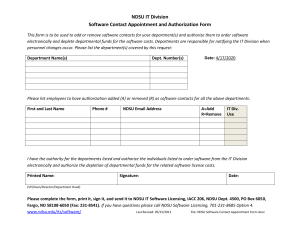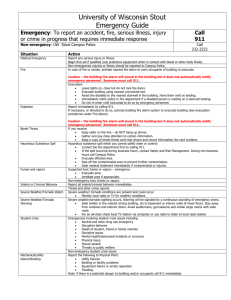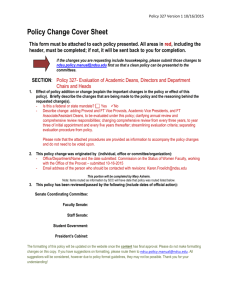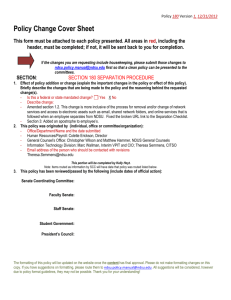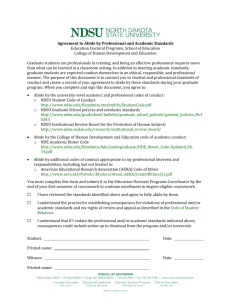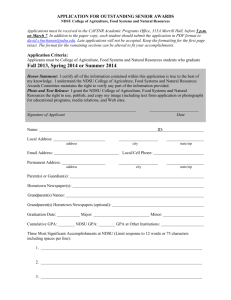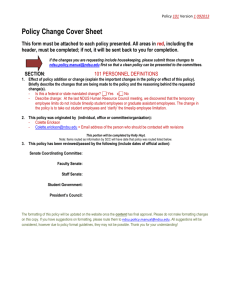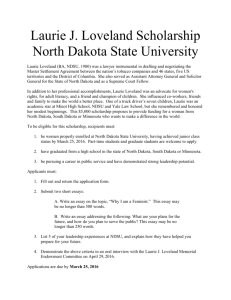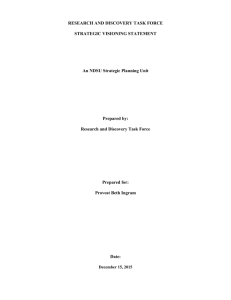Policy Change Cover Sheet This form must be attached to each
advertisement
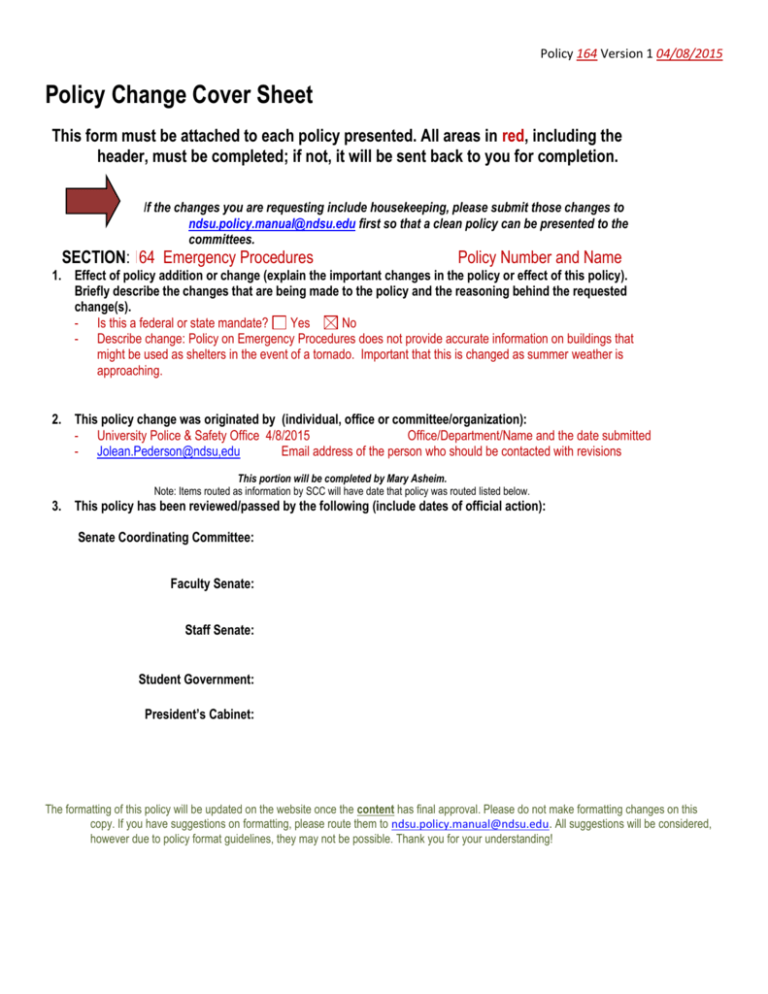
Policy 164 Version 1 04/08/2015 Policy Change Cover Sheet This form must be attached to each policy presented. All areas in red, including the header, must be completed; if not, it will be sent back to you for completion. If the changes you are requesting include housekeeping, please submit those changes to ndsu.policy.manual@ndsu.edu first so that a clean policy can be presented to the committees. SECTION: 164 Emergency Procedures Policy Number and Name 1. Effect of policy addition or change (explain the important changes in the policy or effect of this policy). Briefly describe the changes that are being made to the policy and the reasoning behind the requested change(s). - Is this a federal or state mandate? Yes No - Describe change: Policy on Emergency Procedures does not provide accurate information on buildings that might be used as shelters in the event of a tornado. Important that this is changed as summer weather is approaching. 2. This policy change was originated by (individual, office or committee/organization): - University Police & Safety Office 4/8/2015 Office/Department/Name and the date submitted - Jolean.Pederson@ndsu,edu Email address of the person who should be contacted with revisions This portion will be completed by Mary Asheim. Note: Items routed as information by SCC will have date that policy was routed listed below. 3. This policy has been reviewed/passed by the following (include dates of official action): Senate Coordinating Committee: Faculty Senate: Staff Senate: Student Government: President’s Cabinet: The formatting of this policy will be updated on the website once the content has final approval. Please do not make formatting changes on this copy. If you have suggestions on formatting, please route them to ndsu.policy.manual@ndsu.edu. All suggestions will be considered, however due to policy format guidelines, they may not be possible. Thank you for your understanding! North Dakota State University Policy Manual _______________________________________________________________________________ SECTION 164 EMERGENCY PROCEDURES SOURCE: NDSU President The purpose of the following emergency procedures is to provide for an immediate and orderly response to situations so the well-being of faculty, staff, students, and visitors will be assured. 1. EMERGENCY SERVICES 1.1 Ambulances/Fire/Police/Sheriff: 911 When dialing, remain on the line, give location and describe problem. 1.2 Employees should become familiar with evacuation procedures and guidelines in the "Personal Safety & Security on the NDSU Campus" handbook. 1.3 The Communication Call Center will serve as an Emergency Control Center in the event of campus emergencies. 2. SEVERE WEATHER / NATURAL DISASTER 2.1 During periods of severe weather, one of the following three statements will be made through area media by the University and, when necessary, by department heads: 1) the University will be in full operation, 2) classes are to be canceled, or 3) the University is closed. 2.1.1 Employees who are unable to report to work when the University remains open during inclement weather shall notify their supervisor at the beginning of their work day and take annual leave or leave without pay. 2.1.2 When classes are simply canceled, all personnel will be on regular duty even though classes are not held. 2.1.3 Only "key employees" may be required to work during the period when the institution is officially closed. All other employees will be granted leave with pay for hours which they would normally work during the storm period. "Key employees" shall be designated in writing by each department. During the emergency the department head may authorize other regular employees to work as "key employees." 2.2 Upon reopening of the University, regular policies and procedures will be in effect. 3. TORNADO 3.1 When the threat of a tornado is imminent, the city/campus emergency sirens will be activated. 3.2 Stay calm and seek an area of safety immediately and monitor local weather announcements if possible. 3.3 If you are outside, seek shelter in a nearby sturdy building if time permits, or lie flat in a ditch or low-lying area. 3.4 If you are inside a building, seek shelter immediately in the lower level or interior hallway or room of the building, get under something sturdy, stay away from outside windows and walls, and assume a crouched position with arms over your head. 3.5 If you are in a vehicle in the immediate path of the tornado, get out immediately and seek an area of safety if time permits, or if unable to leave the vehicle, ensure the lap/shoulder belt is on, and cover your head with your arms and/or any other protective items available to you such as coats, blankets or cushions. 3.6 Remain in an area of safety until the all clear has been provided by the weather announcements or other emergency authorities. CHEMICAL/RADIATION ACCIDENT 4.1 In the event of a serious chemical or radiation spill or accident, call 911, or report the circumstances to the Safety Office, 231-7759. 4.1.1 Be prepared to give specifics (e.g. chemical/radioactive material, building name, room number, person[s] injured, etc.) 4.1.2 If necessary, evacuate the building by activating the fire alarm. Refer to building evacuation instructions posted in the building. 4. BOMB THREAT If you need information regarding a bomb threat, please contact the University Police (231-8998). 5. FIRE REPORTING AND BUILDING EVACUATION PROCEDURES 6.1 Know how to activate the fire alarm system, and sound the nearest alarm in the building. 6.2 Alert the Fire Department at 911 from the nearest telephone from which you can safely call. Provide them with: 1. 2. 3. 4. 6.3 Your name (calling from NDSU) Location of the fire (building name, room #) Extent of the fire, and If applicable, indicate that someone will be at a specific entrance to the building to give directions. Calmly alert people in the building and evacuate the building by following the EXIT signs. DO NOT USE THE ELEVATORS. When a fire alarm is activated, ALL PERSONS MUST EVACUATE THE BUILDING IMMEDIATELY! 6.4 Once an alarm has been activated and immediate attention has been given by emergency personnel to the safety of others, and if it is safe to do so, close corridors, windows, doors, and stairwells to prevent the spread of fire and smoke. 6.5 Remain outside of the building at a safe distance. 6.6 Meet police or fire personnel upon their arrival to direct them to the fire. 6.7 Emergency fire systems, such as fire extinguishers and fire alarms, must be in a state of readiness at all times. It is a criminal offense to tamper with firefighting equipment or to sound a false alarm. In instances where the fire alarm is utilized to evacuate buildings as in the case of a bomb threat, the alarm is to be activated only upon authorization of the main administrative office in the building. __________________________________________________________________________________________ HISTORY: New Amended Amended Amended Amended Housekeeping Housekeeping July 1990 December 1992 June 1994 May 1995 January 1996 March 21, 2013 October 2, 2014
